|
FAQs about Marine Shrimp
Identification 2
Related FAQs:
Shrimp
Identification 1,
Shrimp Identification 3,
Shrimp Identification
4,
Related FAQs:
Marine Shrimps
1, Shrimp Selection, Shrimp Behavior, Shrimp Compatibility, Shrimp Systems, Shrimp Feeding, Shrimp Reproduction, Shrimp Disease, Cleaner
Shrimp, Banded Coral
Shrimp, Dancing Shrimp,
Harlequin Shrimp, Pistol Shrimp, Saron Shrimp, Mantis
Shrimp, Anemone
Eating Shrimp, and More FAQs on
Marine Shrimp, Crustacean Identification, Crustacean Selection, Crustacean Behavior, Crustacean Compatibility, Crustacean Systems, Crustacean Feeding, Crustacean Disease, Crustacean Reproduction,
Related Articles: Shrimp,
A Few Common Shrimps for the Marine Aquarium by James W.
Fatherree,
|
|
| Xeniid shrimp id AntBuboine, can you id
this Palaemonid for me? You had said someone sent you a pic
recently... Boub |
|
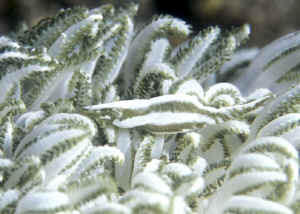
|
| Hippolyte commensalis (Xeniid shrimp) Holy
cow, Bob! How did you see this little bugger?!?!? <Found by the
dive guide... I would gladly 'fess up otherwise 'twere it
so> You are the man... seriously: Hippolyte commensalis
<We're da fishmen!> a gorgeous critter on a gorgeous
coral <G>. I should not be surprised to admit it... and it
took me long enough (thanks mostly to your tireless efforts)...
but, I'm a dreaming and a hankerin to do some serious (but safe
<G>) reef diving. <Omigosh!> Still got tons to work out
at home... as you know, my grandparents were/are everything to me.
These years are precious. We took my gram to the docs today too for
more tests... there are some sobering concerns re: leukemia now.
Will be taking her for second tests next week :( And then to Cape
May, NJ for a quaint retreat for a few days thee following week (Di
knows/likes Cape May Point?... 'tis my speed :) <Okay> At
any rate... the dive vacation that I promised myself after we
finished NMARI... I will take after NMA RF <VBG>. Time and
funds allowing :) Maybe Fiji. <Let me know when, and let's
go> I thank you sincerely for your inspiration in so many ways
to me, my friend. Antoine <The feeling's mutual compadre.
Bob F> |
Shrimp ID - 8/31/03 Can you Identify this type of shrimp
please. He looks like a banded but with out the bands. Comes from
Florida waters this I know. He was a live rock hitch hiker. <looks
like Brachycarpus biunguiculatus - the Two Claw Shrimp. Anthony>
|
Correct shrimp ID before placement
12/25/16
Hi and Merry Christmas Happy Holidays!
I have been trying for months to identify this shrimp, every time I think I
have it nailed down something changes or further research seems to
disqualify what I thought and I second guess myself. First a little
background, we are in a marina in Ft Pierce FL at the
junction of the intercoastal and the FT Pierce inlet. About 4-5 months ago I
was checking
the water ,incoming tide, for little fishes when I saw what first appeared
to be a small 1/2" piece of solid green sea grass or weed, as straight as
and about half the width of a toothpick, it was "floating" differently than
the other pieces of plant debris around it. On closer inspection I
determined it to be a shrimp. I thought it was acting like it was injured or
weak. As I hadn't seen one before (or since). I took it to ID and have been
amazed at its continuing growth and changes, which has hindered the
identifying of it. I started him in my smallest tank 3 gal and he has now
reached the point my bigger 20 gal tank is getting too small. The Manatee
center is very interested in it but I would want to provide a correct ID.
He now is about 4 1/2" long excluding the antenna, the
antenna are approx 1/2 - 3/4 of an inch longer than the shrimp. The antenna
are very fine with wide bands matching the green and tan(ish) body colors.
There are no larger
pincers on the first set of legs, but each leg ends in uniformly sized
smaller pincers and are banded like the antenna . Where the swimmerets meet
the abdomen there are beautiful blue with yellow spots. He has a nicely
shaped fan tail with 4 fins carrying the same color scheme with the same
type banding on the very edges of the two outer most fins. He seems to enjoy
both algae wafers, shrimp meat and fish meat (which my anemone enjoys also).
As I stated earlier he started out very straight and solid bright green,
sometimes dark green others a brighter green, then about a month in
he got more of a bent stick shape and I was positive he was a Tozeuma,
<Mmm; no... this genus is found in the trop. W. Atlantic; but this isn't a
member>
but again changed my opinion as he grew, into the shrimp in the attached
photos. When with a fish almost as big as he, it looked at times like he was
trying to caress the fish with his antenna, perhaps like a cleaner would.
<More likely testing it as a food item>
He is a majestic beast and I would love to see him in a forever tank where
he could help educate youngsters, that is why I am eager to do a correct ID
on this fellow.
As always you, the whole wet web media team, are an awesome group of folk!
Thank you in advance
Kittie Schwebel
<My best guess, gauging from body morphology, growth/size... is that this is
a Penaeid; likely Penaeus monodon... the Asian Tiger Shrimp... a contaminant
(non-local) sometimes found in the Gulf... Bob Fenner>
|
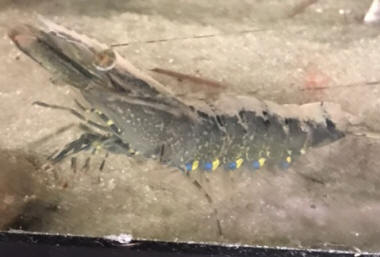
 |
|
Shrimp ID
6/20/14
Hey Guys,
<Sam>
Just looking to get an ID on these guys. Picked them up from my local
collector who isn't sure what they are either.
<Local... where in the world? A useful clue>
They're currently playing nice and hanging out with my blood shrimp pair
Any ideas?
<Nothing I've seen, nor see in my home ref. works. Am sending on to
LynnZ for her go over. Bob Fenner>
Sam
|
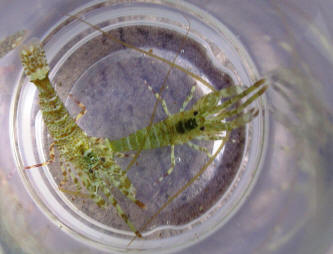
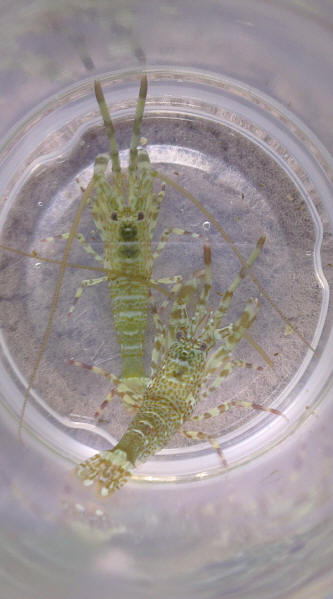 |
|
Shrimp ID: 6/21/14
Hey Guys,
<Hey Sam, Lynn here today>
Just looking to get an ID on these guys. Picked them up from my local
collector who isn’t sure what they are either.
<Unfortunately, I can’t give you a concrete answer. I’ve not seen these
shrimps before and don’t have access to my research materials at the
moment. The best I can do is offer a link so you can pursue the ID on
your own, if desired. The process will require a crash course in shrimp
anatomy and an eye-opening experience into just how detailed and
seemingly minuscule some of the identifying factors can be for ID to
even the family level, much less genus and species. The good news is
that since you have the specimens on hand, you can see all those little
details that don’t show up in the photos. For example, which legs (if
any) are “chelate”, that is, have claws/pincers on them? Another factor
that’s very important, is the shape and length of the rostrum (the
beak-like extension of the carapace, between the eyes). All in all, if
you can succeed in identifying to the family level, you’ve done a great
job! If you can get it to genus level – wow, now that’s bonus points!
Please see the following link to get started (*big* pdf file, so it may
take time to download):
FAO Guide to Shrimps and Prawns (this covers the W. Central Pacific, but
it discusses some basic family-level traits):
ftp://ftp.fao.org/docrep/fao/009/w7192e/w7192e13.pdf
If you really want to dig in, go to the following site, click “Full
Description (from SIRIS)”, and peruse the links/families provided. Just
be prepared – you may not surface again for several days!
http://www.sil.si.edu/smithsoniancontributions/Zoology/sc_RecordSingle.cfm?filename=SCTZ-0587
>
They're currently playing nice and hanging out with my blood shrimp
pair.
<Yay – who needs a name anyway! Just keep an eye on them (and the rest
of the livestock) and feed as you would your other shrimps.>
Any ideas?
<See above – good luck!>
Sam
<Take care, Lynn Z>
<<Yeeikes! Thank you Lynn. BobF>>
|
|
Shrimp ID 12/12/13
Hello all,
<Kyle awhile>
So I have found four of these guys in a shipment of live rock we got at
work. I'm not too terribly familiar with most shrimp and was hoping
someone there could shed some light.
What I Know:
Came from the coast of Florida (Gulf side)
<Mmm, don't see in Humann & DeLoach>
Largest found was around 2"
Seem to be terrified of everything
Mostly clear with orange speckling/bands
Dark, almost black eyes
My first guess was some sort of anemone shrimp, though none were found
associated with anemones. They aren't inquisitive like cleaner shrimp
and bolt away from everything, including their own reflection. They
aren't pistol shrimp, unless these just happen to be pacifists that left
the pistols behind. The closest ID I could come up with is Brachycarpus
biunguiculatus, the Florida Two Claw Shrimp. Unfortunately those
pictures seem to show a striped eye (which these don't have) and far
more color...
Any thoughts?
<Might be Brachycarpus biunguiculatus; just juvenile, or
regional variation>
I know ID is tough without a good rostrum picture, but if they are a
glass or anemone shrimp, what are the chances its reef safe?
<... the long rostrum; serrated above and below... other char.s. My
guess is some species of Palaemonid...>
PS: Sorry if the picture isn't great - all I have at work is my cell.
Kyle Thaman
<Not likely "very problematical" in terms of chewing/eating other
desirable reef livestock. Bob Fenner>
|
/Shrimp3[1].jpg) |
|
Mysterious Creature ID - 11/17/12
Hi Crew,
<Hi Ashley>
I found a strange looking creature in some macro algae that I got and wanted
to know if you can identify it and let me know if it is harmful or not. I
hope the pics are clear enough for you to get an idea.
<Pictures appear to be a Caprella sp. Commonly called Skeleton shrimp,
harmless.---
http://www.marinespecies.org/aphia.php?p=taxdetails&id=101361
>
It looks like a cross between a stick bug, praying mantis and an inch
worm. It has 2 antennae like things on it's head, 2 arm like features
<Gnathopods.>
, hence the praying mantis part, and several suction like feet that attach
to whatever it is on, like caterpillar feet,
< Pereopods, used for grasping.>
and it moves like an inch worm. It mostly stands upright in the water on
the Chaeto, holding on with it's feet. The tank it is in just has pods, a
feeder shrimp or 2, 2 red Mithrax crabs, 2 tiny hermits and macro algae.
Would it be safe for me to put my Mandarin Goby in this tank with this
"thing"?
<Mandarin may try to eat it. Good eye spotting the little guy!>
Thanks for your time and endless knowledge!
<Quite welcome.>
Ashley
<Jordan>
|
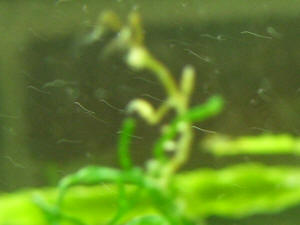
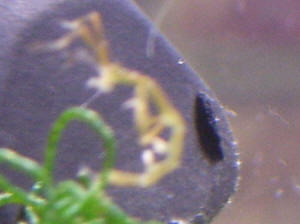 |
Re: Mysterious Creature ID 11/17/12
Jordan,
<Ashley>
Thanks for the quick reply. That is exactly the creature I have!
<Excellent.>
Thanks for the website link too. I tried to figure it out by searching
images online but didn't know if it was a worm or what, to know how to
search for it.
<That can make it difficult.>
I knew one of the crew would know :)
<Here to help>
Ashley
<Jordan> |
|
Shrimp ID 11/7/11
Crew,
<Phil
We have an established marine tank and have recently noticed this
shrimp in the tank.
<Mmm, where?>
It is sort of hairy, all we have ever put in the tank were
peppermint shrimps, but that was way back, never seen them.
Any ideas?
<I can't make out what you're referring to in your
pic... Maybe tempt it out w/ food to get a better image>
Regards Phil
<And you, Bob Fenner>
|
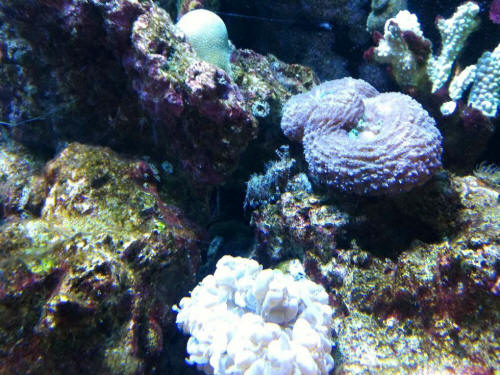
|
Shrimp ID 11/7/11
Bob,
<Phil>
Got him right in the light
Looks like something from pre historic days!!
<Ahh! Looks to be a Saron sp. Please see here: http://wetwebmedia.com/saronshrimp.htm
and the linked FAQs file above. BobF>
Regards Phil
|
|
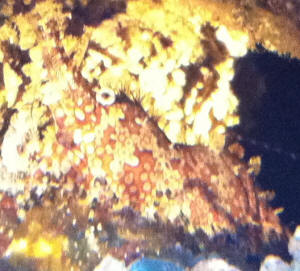
|
Re: Shrimp ID
11/7/11
Many thanks!!!
Phil H
<As many welcomes. Neat animals. B> |
|
|
shrimp id 6/7/11
Trying to identify this shrimp caught on East coast of
Georgia...I caught three off my dock and have never seen
before.
Michael Burdette
<Mmm, this looks like one of the three species of Penaeid
shrimp that occur off the US E. coast. White shrimp (Litopenaeus
setiferus), pink shrimp (Farfantepenaeus duorarum) and brown
shrimp (Farfantepenaeus aztecus). Likely this is the first. Do
you have other photo/s of the head region? Bob
Fenner>
|
|
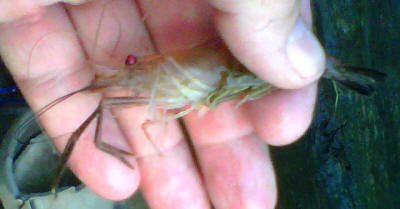
|
Re: shrimp id 6/7/11
No but will go out this evening and try to catch another. All three
had eggs and I threw them back. We have a Lg population of brown
and white although the whites were hit hard by cold. Just never saw
with pinchers before in 48 yrs on Georgia coast.
<Interesting... am given to suggest this might be
Macrobrachium... from where though?>
Will try to get better pics tonight.
Thanks
<Thank you, BobF>
Re: shrimp id
Caught in predominately brackish water river.
Ogeechee River. About 10 miles upstream from intercoastal.
<Gosh; am reliving (sans former LSD exposure) "Apocalypse
Now" footage re... Do see the various species of
Macrobrachium's pix on the Net... B>
Re: shrimp id
Macrobrachium dux looks very close
<Mmm, a recruit... Ala an unfavoured Pteroine off your coast at
times/places. B>
Re: shrimp id 6/7/11
Have looked at pics I see known exact...although could be im-mature
compared to pics. I will try to catch more and take pics with
camera other than phone for more details.
<Real good. B> |
|
Snapping Shrimp ID? Nope, Thalassinidean -
8/26/10
Hello all!
<Hello Donna, Lynn here today!>
I own a saltwater reef store in Las Vegas
<Neat!>
..and can't count how many times you guys have helped me
silently.
<That's great, I'm glad we've been able to
help.>
I was sent an "assorted snapping shrimp" and before
selling it I would like to ID it if possible.
<Good for you! The more you know, the better chance that
little shrimp has of ending up in a system that suits its
needs.>
It is without a doubt one of the coolest ones I've ever
seen.
<It is, indeed.>
It does look to be Alpheus Sp. judging by the claws but I
can't find anything that even remotely resembles it on the
web.
<Yep, although the claws do look similar, and are unequal in
size, this is another creature entirely. It appears to be a
Decapod crustacean in the infraorder Thalassinidea, aka
'Ghost', 'Mud' or 'Sponge' shrimps. This
group is typically comprised of deposit/detritus-feeders and
filter-feeders. I believe your individual belongs in one of two
families: Callianassidae ("Ghost shrimps": big-time
burrowers, combination deposit and filter-feeders), or something
in the family Callianidaeidae, (shrimps associated with
reef/rubble habitats that tend to burrow or hang out under
rocks/within rockwork). I wish I could narrow it to one family or
the other, but I can't quite see enough detail to make that
determination. At any rate, I'm leaning towards the latter
family, namely those species in the genus Callianidea. If your
individual came from the Indo-Pacific region, it could easily be
Callianidea typa as it seems to be a fairly common, widespread
specie. As far as diet, I couldn't find any specific
information, but it's likely another deposit/detritus-feeder
that would do best in a mature system with a deep sand bed,
rockwork, and rubble. As with any potential burrower, there's
always the possibility of undermined rockwork and rearranged
aquascapes, so that should be kept in mind for anyone wishing to
take this little fellow home. Please see the following links for
examples of Callianidea typa:
http://24.dtiblog.com/c/calappa/file/20090224111920.jpg
http://www.flmnh.ufl.edu/reefs/guamimg/crustacea/crusties/Pages/Image18.html
Family Callianassidae, genus Calianassa:
http://www.marinelifephotography.com/marine/arthropods/shrimps/callianassa-1.htm
Good basic information link re: Thalassinidean shrimps: http://museumvictoria.com.au/crust/thalbiol.html
>
Thanks in advance for your help.
<You're very welcome.>
Donna
<Take care, Lynn Z>
|
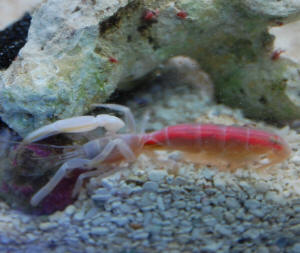 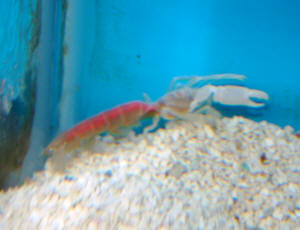 |
|
|

